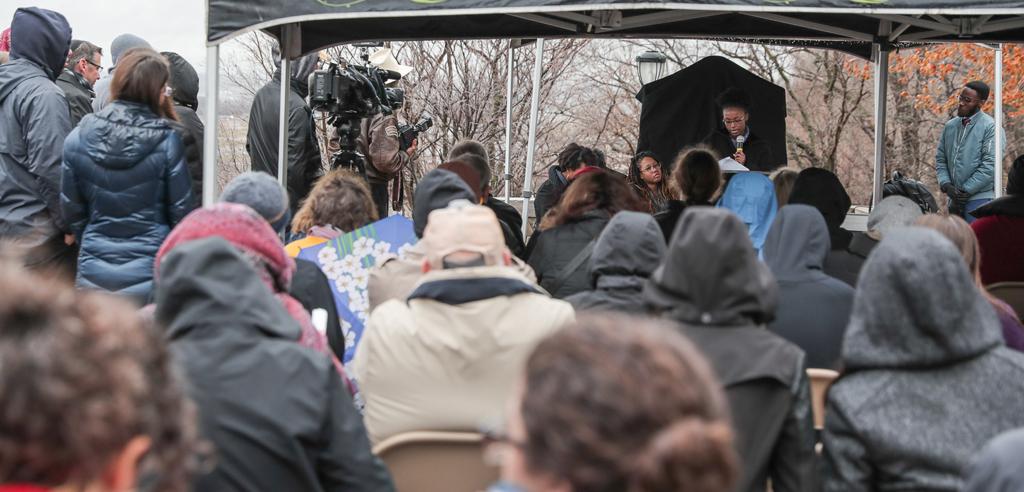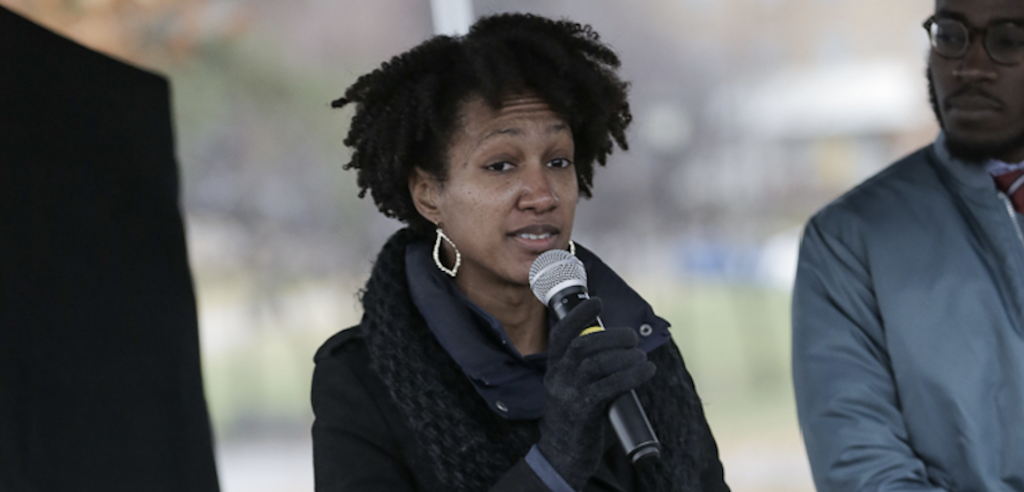On December 1, community members and civic leaders gathered with EJI in Kansas City, Missouri, to unveil a historical marker to memorialize the racial terror lynching of Levi Harrington as part of EJI’s Community Remembrance Project.
About 120 people attended the dedication ceremony, which began with a performance of the iconic song, Strange Fruit, and the reading of a proclamation signed by the Mayor of Kansas City dedicating December 1, 2018, as Levi Harrington Remembrance Day.
EJI announced the winners of our Racial Justice Essay Contest and awarded them $5000 in scholarships. First place winner and Ruskin High School senior Alexis Frazier read her essay, entitled The Bridge Between Ruby and the Children. Second place was awarded to Thresa Kelly, a senior at Lincoln College Prep Academy; third place went to Nia Stewart, a senior at Northeast High School; in fourth place was Seth Phillips, a senior at Lincoln College Prep Academy; and Vivian Nguyen, a junior at Lincoln College Prep Academy, received an honorable mention.
Reverend Dr. Cassandra Gould of Missouri Faith Voices led community members in a healing ritual, and the program closed with a prayer by Reverend Dr. Rodney Williams of the Kansas City NAACP.
The marker dedication was made possible by a collaboration between The Black Archives of Mid-America in Kansas City, the Missouri Conference of the NAACP, Missouri Faith Voices, Missourians for Alternatives to the Death Penalty and EJI.
MADP head Staci Pratt told KCUR that there is a “connection between the regions in Missouri, where we’re engaging in capital punishment, producing executions, have more pending capital cases and the historical practice of lynching.”
In Missouri today, she said, a person is 14 times more likely to get the death penalty if the victim is a white female than if the victim is a Black male. Like lynchings, death sentencing decisions “are not made upon a methodical examination of what is considered the worst of the worst crimes. They’re made on a structure that is meant to reinforce racial hierarchies.”
The Lynching of Levi Harrington
Levi Harrington was a well-respected African American man who lived with his wife and five children near Kansas City. One of Mr. Harrington’s former employers described him as a “faithful…honest man,” who “was sober and industrious, saved his money, and cared for his family.”
On April 3, 1882, a police officer was fatally shot in Kansas City, and suspicion was immediately directed towards Black residents. During this era, deep racial hostility burdened Black people with presumptions of guilt, often resulting in accusations that were unfounded and unreliable.
Many African Americans were lynched across the South under accusation of murder. During this era of racial terror, mere suggestions of Black-on-white violence could provoke mob violence. The deep racial hostility permeating Southern society often focused suspicion on Black communities after a crime was discovered, whether or not there was evidence to support that suspicion, and accusations against Black people were rarely subjected to serious scrutiny.
As Mr. Harrington made his way through Kansas City that day, he was stopped by police and arrested. Despite the lack of evidence to indicate his involvement in the shooting, an angry white mob quickly formed and grew to several hundred people intent on lynching Mr. Harrington.
The mob forcefully seized Mr. Harrington from police custody and lynched him by hanging him from a beam on the Bluff Street Bridge and shooting him.
It was not uncommon for lynch mobs to seize their victims from jails, prisons, or courtrooms. Though they were armed and charged with protecting the people in their custody, police almost never used force to resist white lynch mobs intent on killing Black people.
Although newspapers reported that Mr. Harrington was innocent of the accusations against him, no one was held accountable for the lynching of Levi Harrington.
EJI’s Community Remembrance Project
EJI’s Community Remembrance Project is part of our campaign to recognize the victims of lynching by collecting soil from lynching sites, erecting historical markers, and developing the National Memorial for Peace and Justice which acknowledges the horrors of racial injustice.
As part of its effort to help towns, cities, and states confront and recover from tragic histories of racial violence and terrorism, EJI is joining with communities to install historical markers in communities where the history of lynching is documented. EJI believes that by reckoning with the truth of the racial violence that has shaped our communities, community members can begin a necessary conversation that advances healing and reconciliation.
Lynching in America
Thousands of Black people were the victims of lynching and racial violence in the United States between 1877 and 1950. The lynching of African Americans during this era was a form of racial terrorism intended to intimidate Black people and enforce racial hierarchy and segregation.
Lynching was most prevalent in the South. After the Civil War, violent resistance to equal rights for African Americans and an ideology of white supremacy led to violent abuse of racial minorities and decades of political, social, and economic exploitation.
In an expanded edition of Lynching in America, EJI also documented racial terrorism beyond Southern borders, detailing more than 300 lynchings of Black people in eight states with high lynching rates in the Midwest and the Upper South, including Oklahoma (76 lynchings), Missouri (60), Illinois (56), West Virginia (35), Maryland (28), Kansas (19), Indiana (18), and Ohio (15).
Lynching became the most public and notorious form of terror and subordination. White mobs were usually permitted to engage in racial terror and brutal violence with impunity. Many Black people were pulled out of jails or given over to mobs by law enforcement officials who were legally required to protect them. Terror lynchings often included burning and mutilation, sometimes in front of crowds numbering in the thousands.
In response to this racial terror and violence, millions of Black people fled the South and could never return, which deepened the anguish and pain of lynching.
Many of the names of lynching victims were not recorded and will never be known, but EJI has documented 60 African American victims of racial terror lynching killed in Missouri during this era.


